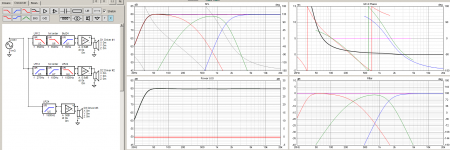0.5 ms is negligible at 1 kHz, however under some circumstances it may be indirectly audible on complex waveforms such as piano arpeggios. The human ear is a capable device in the midrange and it can tell real vs fake just through arrival time delta of many multiple sound sources at once. Many orchestra conductors can point out a single instrument playing wrong in a sea of musicians, even with slower attack waveforms ie violin. If you're as being as thorough as you are with this project, its smart to take this into consideration, especially if you listen to acoustic music.View attachment 1026277View attachment 1026278View attachment 1026279View attachment 1026280View attachment 1026282
More GD graphs from dibirama's measurements. This time just whatever axis looked worse.
The satori WO24P looks like a perfect match for the dynaudio. Hmm.
The sb15NABC might get the award for the least change between the 0 and 30 degree GD,
I do wonder about some of the large GD shifts around 1khz. Low to high some are close to 0.5ms. The paper says no big deal for music sounds so I guess they are fine. I would prefer something tame and with not too many negative GD shifts. I did a test over the summer and think I heard how it can mess up a resonance.
BTW the Satori WO24P is a nice driver for its size. Very low THD and clean usable response well into the midrange. Not cheap but worth it IMO.
Thats the product of a deep cone profile and high Qms. Lots of off axis lobes. Shallower cones are better off axis. This is why a mid dome is better depending on how well the dome profile is optimized.View attachment 1026241
Found this 0-90 degree for the ne123w posted by a forum member. It looks like it has a bit of a GD shift around 700hz. No way of knowing for sure though. I do like the MMS and the price. I don't mind paying more for performance though.
I was just reading something about phase and perception.The human ear is a capable device in the midrange and it can tell real vs fake just through arrival time delta of many multiple sound sources at once. Many orchestra conductors can point out a single instrument playing wrong in a sea of musicians, even with slower attack waveforms ie violin. If you're as being as thorough as you are with this project, its smart to take this into consideration, especially if you listen to acoustic music
https://www.jstage.jst.go.jp/article/ast/23/1/23_1_1/_pdf/-char/en
In these experiments, the stimuli have a flat amplitude spectrum and a group delay spectrum that has a single peak described by a Gaussian function where the mean (center frequency) and the standard deviation (bandwidth) are free parameters of interest. The first experiment was performed using stimuli with different peak values, where the center frequencies are fixed at 1,000 Hz and 4,000 Hz, and the bandwidths are also fixed. These bandwidths are computed by weighting the equivalent rectangular bandwidth (ERB) with certain parameters. It was found that when the peak values of the stimuli are between -1 ms and 2 ms, they are perceived to be zero phase, regardless of their center frequencies and bandwidths. Moreover, when the peak values of the stimuli are less than -8 ms or more than 10 ms and the bandwidths are less than 1 ERB, they are perceived to be similar. This result indicates that the nonzero-phase stimuli are similar when the bandwidth is less than 1 ERB. It was also found that the similarity of the stimuli reduces when the bandwidths of the nonzero-phase stimuli are more than 1 ERB.
This paper is a little more forgiving than the previous one.These results and the results of Experiment 1 imply that the human auditory system is sensitive to the difference between zero-phase and nonzero-phase stimulus and is less sensitive to the difference among nonzero-phase stimuli when the stimulus has a narrow group delay bandwidth (less than 1 ERB). However, if the stimulus has a wide group delay bandwidth of over 1 ERB, then the human auditory system is sensitive to the difference between negative and positive group delay values. In other words, the temporal asymmetry of the stimulus is perceived in this situation.
On my first speaker, I was obsessed with the phase of the XO but ignored the phase of the drivers. I just want to be sure I check those boxes this time around. It seems not too hard to have a 1-2ms GD if one pays attention.
cool. It plus the mw19tx and the 12mu are the top contenders for me. I will know more when I do a box sim and some more baffle sims.the Satori WO24P is a nice driver
The preferred range for flat-ish phase response is 500 - 10 k which emulates a very good full range driver. Beyond that is extremely difficult to get remotely close to flat PR, mainly due to acoustic events "slowing down" in the LF and diaphragm breakup modes, VC Le, diffraction, etc in the HF. The ear isn't that sensitive past 8 k and can't really decipher THD or FR irregularities that well, so concentrating on the magic mid band of 1 k - 5 k is going to get you to your goals quicker.On my first speaker, I was obsessed with the phase of the XO but ignored the phase of the drivers. I just want to be sure I check those boxes this time around. It seems not too hard to have a 1-2ms GD if one pays attention.
I own Manger MSWs and various other FR drivers that can get close to portraying very accurate time coherent audio events, but even those devices need some form of phase correction and steering to fix PR irregularities, which can be worked in your favor depending on their severity through the xover. The enclosure and baffle shape/dimensions will dictate much of that too the more you get down into and past the lower mids. The important thing is to concentrate on what's important and not obsess over things that aren't. Any xover points lower than 1k need to be as close to 1st order as possible (wishful thinking... i know). 2nd order acoustic is more realistic and LR2 elliptical with inverted HF is practical given the resulting inverted leading edge of the HF is "suppressed". There are some designs on the market which employ this strategy to allow for flat-ish PR with a limited bandwidth HF driver - the Lipinski L707 speakers use this method of xover to obtain a smooth LF/HF phase transition. https://www.stereophile.com/standloudspeakers/1205lipinski/index.html
Getting the lower mids right and tying them together correctly with the acoustical space is often neglected in many high end designs - that's probably the most difficult area to tame once the speaker is placed where you expect it to live. The balance of LF to midbass, lower mids and upper mids is the essence of a musically correct sounding speaker. People can spend years on this design area and often give up to settle with a less than acceptable or expected result. its probably the most frustrating thing to deal with if you dont have the measurement gear and/or knowledge to correct it. Taming HF balance is much easier in comparison.
Last edited:
Cool speaker. I am with him for the felt baffles.the Lipinski L707
Including my own! I have been so focused on 1-5khz that I have not re-worked my mid-to-woofer XO since the day I slapped it in there. I need to take new measurements, but here is a GD measurement from last year for my bliesma t25 + eton 3-212 + seas l26roy speaker.Getting the lower mids right and tying them together correctly with the acoustical space is often neglected in many high end designs
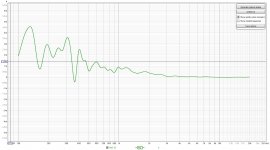
So maybe my ears are just hearing a bad 400hz? What sometimes bugs me is when a song is moving up a scale I hear a bigger shift than expected.
Everything to the right of 700hz looks good now with my informed eyes (I thought the hump at 1khz was the prob. but the GD papers say no). After reviewing all the mids, I want to see if mine has GD issues off-axis.
My wigglers stop around 13,000hz.The ear isn't that sensitive past 8 k
On my first speaker, felt and round edges did help the very high frequencies. It seems like it is easy to have them cancel out on the baffle before you get to hear them. Just my newb 2cents. My tweeters have grills so maybe some of this is that.
Thanks again for the advice and help.
No, it's purely the summation of LR2 slopes. As if the sources were time aligned with DSP to account for different path length delays from driver spacing (and depth offset) on the design axis. With a passive xo finding some low-pass/high-pass curves that sum similarly flat (with the drivers not being time aligned) would be the goal.BTW I was looking at your LR2 XO image again. Do you ever sim with the driver spacing?
Not sure what is meant by GD from driver measurements. Sounds like it's the GD shown for a minimum phase FR graph loaded into Vituix, but of course in that case a GD is a function of the FR. (And worse GD off-axis just comes from the more rolled-off FR.)More GD graphs from dibirama's measurements. This time just whatever axis looked worse.
Last edited:
Ah. Thanks for explaining.No, it's purely the summation of LR2 slopes. As if the sources were time aligned with DSP to account for different path length delays from driver spacing (and depth offset) on the design axis. With a passive xo finding some low-pass/high-pass curves that sum similarly flat (with the drivers not being time aligned) would be the goal.
I am loading the impulse from the 3rd party site into REW.Sounds like it's the GD shown for a minimum phase FR
Yeah, I am aware of that.And worse GD off-axis just comes from the more rolled-off FR.
Here is the scanspeak d7608. The 0-60 deg. on hificompass vs the 0 and 30 deg. GD plot from dibirama.
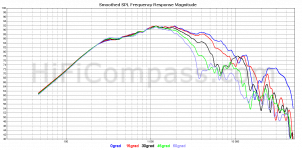
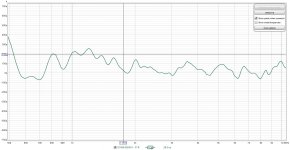
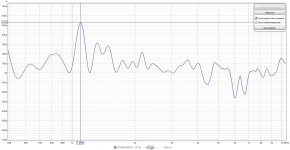
The GD makes it easier to see the shifts in time.
Been thinking about different directions for the new project and I might pivot a bit to get a perspective. I am ordering a visaton dsm50 ffl to try out some ideas and A/B with my 3" mid.
As a little side project, I will try to replace the plate on the dsm50 (if possible) and add an sb acoustics SB14ST-C000-4. A 1/4 WL XO might be possible around 2300hz. Will it play loud? No. But I have heard this tweeter in the cheap SBA coax and liked it.
I don't know what will happen sticking the two drivers next to each other. The sb14 is made to go into a woofer so it should be fine?
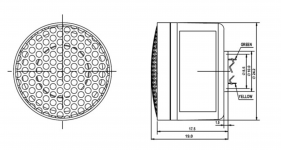
For a 3way with a dome mid and 1st order xo's the way I have them in my prev. posts, I am worried about Linkwitz's warning:

My mind goes back and forth about using a clean XO's/decay VS using 1st orders and having a bunch of drivers playing the same stuff.
I think it would be cool to have a sort of "in-your-room" sound vs something pinpoint accurate. My aim was to have a large baffle with drivers on either end playing 1khz to do this.
As a little side project, I will try to replace the plate on the dsm50 (if possible) and add an sb acoustics SB14ST-C000-4. A 1/4 WL XO might be possible around 2300hz. Will it play loud? No. But I have heard this tweeter in the cheap SBA coax and liked it.
I don't know what will happen sticking the two drivers next to each other. The sb14 is made to go into a woofer so it should be fine?

For a 3way with a dome mid and 1st order xo's the way I have them in my prev. posts, I am worried about Linkwitz's warning:

My mind goes back and forth about using a clean XO's/decay VS using 1st orders and having a bunch of drivers playing the same stuff.
I think it would be cool to have a sort of "in-your-room" sound vs something pinpoint accurate. My aim was to have a large baffle with drivers on either end playing 1khz to do this.
I think you can stretch your 1/4 wavelength spacing rule to 1/3 or even 1/2 wavelength without imparting any real-world practical consequences. The modelling power of VituixCad2 enables you to see the impact.
Regarding 1st order crossovers: In the early 1990's I auditioned numerous loudspeakers. I was always impressed by Vandersteen and Thiel speakers, both of which use 1st order acoustical filters, and which claimed to be "phase coherent". Stereophile verified the claims in several (many) reviews where they showed that speakers from both companies could reproduce a square wave signal and/or a step response on the design axis. Duntech / Dunlavy was also in the same category, but I never had the opportunity to audition those.
The Thiel and Vandersteen speakers I heard were excellent, although they sounded different from each other due to how they were voiced. However, I did not feel that they were uniquely good. There were other speakers which impressed me just as much, and some which impressed me more, and those others were NOT "phase coherent". So, I concluded then that while "phase coherent" design might contribute to good sound, it was not a prerequisite to good sound.
Since then, my thinking has evolved. I now believe that the Vandersteen and Thiel are good speakers because of the constraints placed on the designers by the requirements of 1st order crossovers. This requirement drove them to use exceptionally well-behaved drivers with low distortion and linear behavior over a very wide bandwidth. The requirement to reproduce a square wave drove them to minimize diffraction, and both companies were pioneers in low-diffraction baffle design. Their cabinets needed to be devoid of audible resonance. I believe it is all these byproducts of the 1st order design which made these speakers sound so good... not the 1st order design itself.
As a practical compromise, I prefer to work with 2nd, 3rd, and 4th order filters.
Regarding 1st order crossovers: In the early 1990's I auditioned numerous loudspeakers. I was always impressed by Vandersteen and Thiel speakers, both of which use 1st order acoustical filters, and which claimed to be "phase coherent". Stereophile verified the claims in several (many) reviews where they showed that speakers from both companies could reproduce a square wave signal and/or a step response on the design axis. Duntech / Dunlavy was also in the same category, but I never had the opportunity to audition those.
The Thiel and Vandersteen speakers I heard were excellent, although they sounded different from each other due to how they were voiced. However, I did not feel that they were uniquely good. There were other speakers which impressed me just as much, and some which impressed me more, and those others were NOT "phase coherent". So, I concluded then that while "phase coherent" design might contribute to good sound, it was not a prerequisite to good sound.
Since then, my thinking has evolved. I now believe that the Vandersteen and Thiel are good speakers because of the constraints placed on the designers by the requirements of 1st order crossovers. This requirement drove them to use exceptionally well-behaved drivers with low distortion and linear behavior over a very wide bandwidth. The requirement to reproduce a square wave drove them to minimize diffraction, and both companies were pioneers in low-diffraction baffle design. Their cabinets needed to be devoid of audible resonance. I believe it is all these byproducts of the 1st order design which made these speakers sound so good... not the 1st order design itself.
As a practical compromise, I prefer to work with 2nd, 3rd, and 4th order filters.
I think I read somewhere that kimmosto states that 1/2 wl spacing is actually the worst possible, in terms of power response and expected in-room response. You either go tighter or wider, just not that.
If I recall, he said that the range from 0.7 to 1.0 wavelength is the worst. He advises a spacing of 1.2 wavelength if the spacing can't be kept under 0.5... I can't find his post just this minute. It was either at HT-review or at ASR, but it has been linked on this website somewhere.
or maybe I am misremembering it... ?
or maybe I am misremembering it... ?
https://www.diyaudio.com/community/threads/vituixcad.307910/page-139#post-6541438If I recall, he said that the range from 0.7 to 1.0 wavelength is the worst. He advises a spacing of 1.2 wavelength if the spacing can't be kept under 0.5... I can't find his post just this minute. It was either at HT-review or at ASR, but it has been linked on this website somewhere.
or maybe I am misremembering it... ?
I think you are right.I think you can stretch your 1/4 wavelength spacing rule to 1/3 or even 1/2 wavelength without imparting any real-world practical consequences.
I still would like to test out my ears and have you over to test yours too.
I can't find much info on nulls and audibility and this little setup should make it easy to try out.
I think I read somewhere that kimmosto states that 1/2 wl spacing is actually the worst possible
If I recall, he said that the range from 0.7 to 1.0 wavelength is the worst. He advises a spacing of 1.2 wavelength if the spacing can't be kept under 0.5... I can't find his post just this minute. It was either at HT-review or at ASR, but it has been linked on this website somewhere.
or maybe I am misremembering it... ?
Yeah, 0.5WL has bad nulls. My first speaker uses a 0.46WL and some delays to point the nulls up and down.
Most of the spacing is about pointing the nulls and power in an even way.
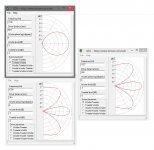
top left is 0.46WL. Bottom left is 1.2WL.
here is a sim of a 0.46wl vert:
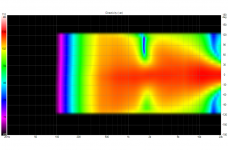
My hunt for mid-woofers continues. A visaton 130m is on the way (could be 8 weeks though) to measure.
Another driver that interests me is the kartesian Mid120_vHE to handle 1khz on down. I'll try a sim with it next.
https://www.kartesian-acoustic.com/copie-de-twt30-vms
more in the video:
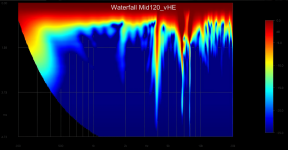
This is from the video...looks darn clean!
Another driver that interests me is the kartesian Mid120_vHE to handle 1khz on down. I'll try a sim with it next.
https://www.kartesian-acoustic.com/copie-de-twt30-vms
more in the video:

This is from the video...looks darn clean!
A couple of additional links on that topic:
https://www.audiosciencereview.com/...-on-the-vertical-radiation.23239/#post-775837http://www.htguide.com/forum/showthread.php?44128-VituixCAD-v2&p=639178&viewfull=1#post639178
Flatter and smaller area cone vs. the BMS 5S117 should indicate wide radiation up to 1.5kHz? (They separate 30° and 60° off-axis only above 2kHz in the datasheet.) So could be a good candidate for crossing directly to the T34 tweeter. Based on datasheet numbers the BMS 5S117 has a lot more linear excursion though, and also larger Sd, eyeballing off-axis data on Hificompass it's right around 1.5kHz where drivers with similar cone area start narrowing.Another driver that interests me is the kartesian Mid120_vHE to handle 1khz on down. I'll try a sim with it next.
Thanks for the BMS 5s117 suggestion and the links. The driver looks like a nice value with a monster of a motor. I was shocked to see how high the Bl was for the BMS mid!
I don't know much about the params and this helped me out:
I did find some data on the 5s117:
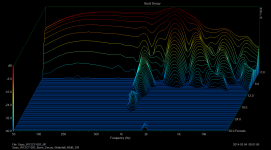
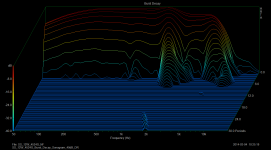
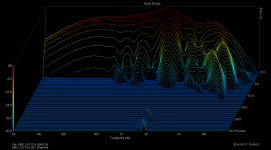

500hz-1000hz the high BL looks to shift the decay in a curve similar to the one in the presentation.
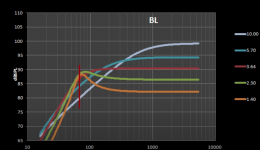
I don't know much about the params and this helped me out:
I did find some data on the 5s117:




500hz-1000hz the high BL looks to shift the decay in a curve similar to the one in the presentation.

That is a huge perk. I don't know how low I want a mid to play. I keep going back and forth about it.the BMS 5S117 has a lot more linear excursion though
Use Bl^2/Re to compare the motor strength of drivers. The BMS has a high Re of 11.4, but it still works out to 2.4x motor strength. The Mms is 2.5x higher, but the Sd is also larger, making up for it. It seems to me both have about the same efficiency in Watt terms. The BMS datasheet shows distortion for 110dB SPL with 100W nominal input. Which sounds like a lot of Watts, I guess take it as a power level for peaks, keeping up with 110dB would also be a tall order for the bass driver below at low frequencies. Based on this 110dB test the distortion takes off below 300Hz.
I wonder about 300Hz LR4, Kimmosto seemed critical about such a 3-way config because of the higher GD from the higher order LPF response. A higher xo frequency (for the same LPF order) would have lower GD, but then the bass driver must play a more extended range. With a lower order LR2 xo at 300Hz more excursion capability from the mid is probably beneficial. Around 300Hz a 5" and 12" could be probably considered being within 1/4 wavelength. BMS has the 12S330 which seems to be good for 300Hz and driven actively it could work in a quite small cabinet.
I wonder about 300Hz LR4, Kimmosto seemed critical about such a 3-way config because of the higher GD from the higher order LPF response. A higher xo frequency (for the same LPF order) would have lower GD, but then the bass driver must play a more extended range. With a lower order LR2 xo at 300Hz more excursion capability from the mid is probably beneficial. Around 300Hz a 5" and 12" could be probably considered being within 1/4 wavelength. BMS has the 12S330 which seems to be good for 300Hz and driven actively it could work in a quite small cabinet.
Last edited:
https://www.diyaudio.com/community/threads/vituixcad.307910/page-183#post-6948950I should ask him if he meant LR4 by that. (It's less critical at higher frequencies as the LPF GD gets less with frequency.)I wonder about 300Hz LR4, Kimmosto seemed critical about such a 3-way config because of the higher GD from the higher order LPF response.
Below is a theoretical setup with LR2 for LF-MF (and LR4 for MF-HF), again assuming perfectly time aligned sources on the design axis. The GD curve looks nicer, flatter below 300Hz vs. LR4. Adding an additional 1st order filter on top of LR2 seems it changes the GD only very little but provides some extra attenuation out of band, seems useful.
Attachments
What's the focus on motor strength for?
Just trying to understand where the middle is. For my 1st speaker, I loosely understood T/S params and even now I still feel like I am flying partially blind. It seems like a larger driver needs a high BL to play high freq. at the cost of having motor noise baked into the decay in the operating range.
...
This is my current hit list. It is crazy how diff. each driver's total weight is. I was mostly searching to see how many drivers on TLHP fit the bill: FS around 100-150hz, A Bl 3-8, and a low MMS.
I was duped by Kartesian. I don't like that it is not made in france. I am on the fence now for that driver.
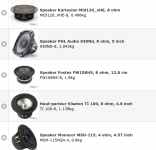
- Home
- Loudspeakers
- Multi-Way
- Headshake's far field 3way
